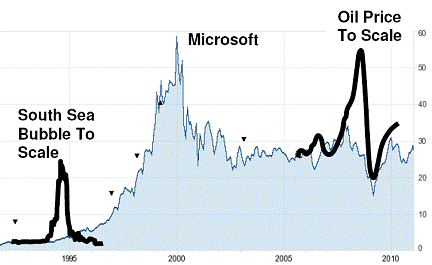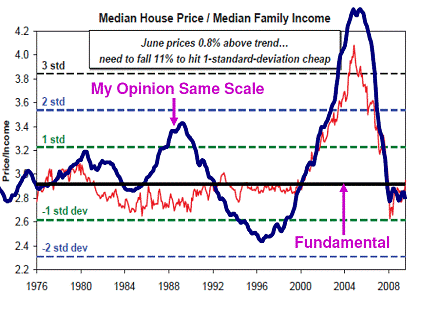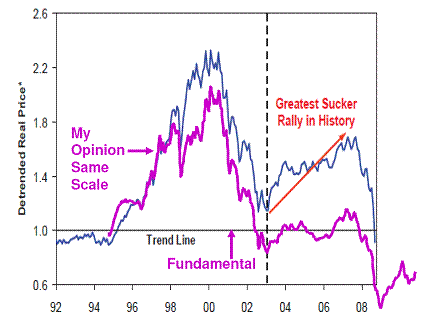Sloppy BubbleOmics: Case-Study John Maudlin And Jeremy Grantham
Stock-Markets / Stock Markets 2011 Feb 04, 2011 - 10:56 AM GMTBy: Andrew_Butter
 John Maudlin recently put out an article called “Pavlov’s Bulls, the Importance of Asset Class Bubbles for Value Investors and Why They Occur”, which pretty much summarizes popular misconceptions about financial bubbles.
John Maudlin recently put out an article called “Pavlov’s Bulls, the Importance of Asset Class Bubbles for Value Investors and Why They Occur”, which pretty much summarizes popular misconceptions about financial bubbles.
http://www.marketoracle.co.uk/Article25998.html
The article contains an essay and a speech by Jeremy Grantham of GMO who, according to John; “is one of the more brilliant and talented value managers”. I have no doubt he is, my beef is that in my opinion, much of what he says about bubbles is wrong.
Jeremy presents his credentials as an expert on bubbles, as follows:
In my 1Q 2009 Letter I wrote, “I am parting company with many of my bearish allies for a while … we could easily get a prodigious response to the greatest monetary and fiscal stimulus by far in U.S. history … we are likely to have a remarkable stock rally, far in excess of anything justified by either long-term or short-term economic fundamentals … [to] way beyond fair value [then 880] to the 1000-1100 level or so before the end of the year.”
Fair enough, that was a good call and Jeremy says that based on that analysis he shifted his weighting in equities from 38% in October 2008 to 62% in 2009; presumably that was in April or May since the “Letter” was 1Q 2009?
Nothing wrong with that, I imagine he must have recouped almost everything he lost on the 38%, and personally having read Jeremy’s essay I would have no hesitation in entrusting a proportion of my (very modest) wealth for him to manage.
Particularly since the person who used to do that tedious and often thankless task for me (my dad) sadly passed away in October 2008. Incidentally by June 2008 he was 0% equities and living in a lovely rented property (plus grounds – great croquet lawn); there again he did set up the Abu Dhabi Investment Authority so he ought to have known what he was doing.
Regardless, that call doesn’t mean Jeremy or in point of fact my dad, know (knew) any more about bubbles than Professor Nouriel Roubini knows about stock markets…he who called the rally from 675 to 1,300 (on the S&P 500) a “dead-cat-sucker-bounce”…about five times.
On the subject of credentials, this is what I said about the S&P 500:
February 2009:“The stock market turn will be when the Dow hits 6,600 and the S&P 500 hits 675…that will be the time to jump in”.
http://www.marketoracle.co.uk/Article9131.html
May 2009: Negligible Risk of Major Reversal Before Dow Crosses 10,000
http://www.marketoracle.co.uk/Article10604.html
January 2010: S&P 500 won’t go above 1,300 in 2010 but it won’t go down much until hits at least 1,200 at which point it risks a 15% to 20% reversal which will be relatively short-lived.
http://seekingalpha.com/article/180450-bubble-onomics-10-predictions-for-2010
So now we have got the name-dropping and “selective memory” part out of the way; on the subject of bubbles…
1: Just because the price went up a lot doesn’t mean there is a bubble:
Jeremy puts up a chart of the South Sea bubble that was originally put up by Marc Faber showing how someone even as brilliant as Sir Isaac Newton could get fooled by bubbles, I’ve compared that with the share price of Microsoft and the recent oil bubble.

The South Sea Bubble went up from about 100 to about 900 in the space of a year (a multiplier of nine); Microsoft went up from about 3 to about 60 in the space of four years (a multiplier of twenty), oil went from about 65 to about 130 (Moving average) in the space of a year (a multiplier of two).
2: Real Bubbles Bounce
The South Sea Bubble was not so much a “bubble” as a scam. What happened there was investors were not given truthful information on the circumstances or the profitability of the company. That is historical fact; what’s interesting is that there wasn’t a “bounce” after the bust, which shows that the company was fundamentally of no value, and in the event it just faded away to oblivion; more like a Madof scam where investors were peddled the illusion of profits, than a real bubble.
Microsoft did have value and still does, but its share-price didn’t bounce either having more or less halved after the 2000 spike; it basically went down to a little under 30 and stayed there.
There was a reason for that, until the anti-trust actions by the US Government started in earnest, Microsoft had a monopoly. Losing that action or at least getting a slap on the wrist, changed the Microsoft business model, and that was reflected in the price, nothing “bubbly-bust” about that.
I suspect that the “valuation” of Microsoft of 60 at the peak of its bubble was probably pretty fair for the information that was available at the time. But then in November 1999 Judge Thomas Penfield Jackson issued his initial findings of fact, that Microsoft held monopoly power and used it to “harm consumers, rivals, and other companies”.
That was a shock particularly to Bill Gates, and if Bill didn’t foresee that he was going to get slapped down to size, investors can be forgiven for not foreseeing that either; that’s not a bubble, that’s the risk of investing.
I suspect also that a lot of the fly-by-night software companies that were listing on the NASDAQ at the time, were using the Microsoft share price in their prospectuses. Saying “look-see this is what geeks like us can do in the real world”, that’s a common way to talk-up the “value” of something that’s hard to value, I do it all the time.
But when the judgement came out, that line started to get questioned, people started to look under the bonnet and found out that whereas Microsoft had a viable business model, the wannabe look-alikes didn’t. So that was the Tech-Bust, and it was all the “fault” of Judge Thomas Penfield Jackson. All I got to say about that is “Three-Cheers for Judge Thomas Penfield Jackson”.
3: A Perfect Bubble
The recent spike in oil prices is an example of a “perfect” bubble. In a perfect bubble the “fundamental” price can be worked out from the square-root of the top of the bubble multiplied by the bottom on the bust, in this case (using the moving average):
Fundamental = √(129 x 47) =$77
That’s about the price oil headed back up to over a period of a year-and-a-half which was how long the preceding bubble lasted, which is also something that happens in perfect bubbles (the fundamental is $85 now, fundamentals change over time).
The other “clue” to a perfect bubble is that the time above the fundamental in the bubble was reflected in the time below the fundamental in the bust.
There is more on that here: http://www.marketoracle.co.uk/Article24849.html
4: Frappuccinos and the “Fundamental”.
I don’t like using the word “fundamental”, but I use it all the same because most people have some sort of intuitive understanding about what that means.
The correct word is “Other Than Market Value” which is the word International Valuation Standards use. And although popular mythology has it that the “fundamental” can be worked out using the “I-Ching” and “Feng Shui”, or some variants on those technologies, an estimate of the “fundamental” is a valuation. It is an opinion of value, and if you want to know how to do a valuation properly, a good place to start is International Valuation Standards (not that they understand bubbles but at least the principles are sound).
A word I hate is “Fair Value” which is an accountancy term that means (to accountants), the “fair” price, as in what you can sell something for today (or could have sold it for yesterday), to someone dumber than you. And that all goes to the wall when you find out you are the dumbest person in the room.
Another thing that irritates me intensely is the way that the “gurus” do their valuations, whether you are talking about Shiller, Smithers, or Roubini, who are just plain sloppy, or in this case Jeremy Grantham who in my opinion is basing his investment strategies on “sloppy seconds”, with all the risks that entails.
Valuation is a serious business. It is after all the oldest profession; in the sense that prior to that other profession which couldn’t have started before two people agreed on a price (requires two independent valuations).
You can’t start a valuation by saying “let’s assume”, as in “let’s assume the world is flat” and “assumption is the mother of all Frappuccinos”.
Example – US house prices:
Jeremy correctly says that house prices ought to have something to do with the incomes of people who live in houses. The implicit hypothesis there is that people typically spend a certain proportion of their income on having a place to live (called “Shelter” by economists), and over time, that proportion is pretty much constant.
That makes sense, although the fact it makes sense doesn’t mean its right; all that means is that it’s an idea worth testing.
But that’s not the whole story, because if people spend that proportion of their income, if suddenly there were half as many houses, the amount of money they would spend, per house, would double. That goes to the fact that “Income per person” with units of [Money per person] is dimensionally not the same as [Money per House] (as in the amount of money people are prepared to pay for a house).
Plotting income per house compared to house prices is simply sloppy, my science teacher at school would have slapped me around the head with a ruler if I did something like that, and then I would have carried the emotional scars all through my life. Sure the number of people per house is pretty constant, but that’s not an excuse for sloppiness.
The other thing is that logically the yield on “risk-free-money” also has something to do with the fundamental price. That’s just valuation 101, one well known way to value real estate is to do a discounted cash flow of anticipated future “revenues” using some variant of the “risk-free-rate” as a variable to work out the Net Present Value (today’s value of future revenues).
Well it’s no different for housing; the owner is foregoing a certain proportion of his income, whether that’s what he could have got as interest instead of paying for the house in cash, or some variant of the mortgage, with the proviso that if he is over-leveraged because he is gambling on the notion the house price will go up, he is gambling (using borrowed money) which is something else completely, and beats “sloppy” every time.
I can imagine at this point you are saying to yourself, “What’s the Big Deal...Who cares about silly little details like that?!”
Well the “Big Deal” is that if whoever it was whose job had been to “Keep America Safe”, from 2002 to 2007 had employed someone who understood how to do a valuation properly, then they would have realized that something was seriously wrong, and they might have done something about it. So in my (humble) opinion, anyone who had that job or who was directly or peripherally involved in that Charlie Foxtrot, and didn’t do their job because they were “sloppy” in their thinking, ought to have been slapped around the head with a ruler, and in which case the world would be a better place.
This is my opinion on house prices compared to Jeremy Grantham’s:

The fact that Jeremy is saying that house prices have got 11% more to go, and I’m saying 15% is not the issue.
What’s important is the understanding that the mal-investments of the past are going to have to be resolved before the market can turn round and that’s not going to really start until prices are 66% of the fundamental; now they are according to me about 90%.
More on that here: http://www.marketoracle.co.uk/Article25597.html
Sure inflation (in incomes) plus a low long-term interest rate; will mitigate the pain, so will subsidies paid with increases in the National Debt, if that’s what the democratically elected government wants. Although the logic of building an economic strategy for a county, so as to mitigate the pain of gamblers who lost their stake; is questionable.
Good government is about weighing the options; there is an argument that a policy based solely “pain relief” might not be the best long-term strategy. An alternative strategy might be to deliver “pain-relief” only to those really suffering (i.e. the poor) rather than to the Wall-Street morons who helped create the mess, and couldn’t do a proper valuation if someone slapped them around the head with a ruler, a hundred times.
That is not what’s happening; the people in America who are really suffering right now are the 80% of the population who “share” 1% of the total financial wealth of the country.
http://www.marketoracle.co.uk/Article25970.html
Example – S&P 500:
Jeremy says in his commercial:
We are likely to have a remarkable stock rally, far in excess of anything justified by either long-term or short-term economic fundamentals … [to] way beyond fair value [then 880] to the 1000-1100 level or so before the end of the year.”
OK, that was Q1 2009, now the S&P 500 is a tad above 1,300 (interesting, I said it wouldn’t go above 1,300 in 2010, in January 2010, and it didn’t…not quite).
So let me get this straight, in the first week of April 2009, the “fundamental” according to Jeremy was 880, now the price is 47% above that. The fundamental can’t have gone up 47% in just under two years, so that’s a bubble…right?
That’s what Shiller’s analysis says (although he doesn’t say that, in fact he’s keeping pretty quiet these days), it’s also what Andrew Smithers who swears by Tobin’s “Q” says (or used to say, but he’s keeping pretty quiet too). Of course no one can get Nouriel Roubini to keep quiet, he still thinks that’s a dead-cat-bounce; as if they make cats out of rubber these days.
So who’s right?
You guessed; in my (humble) opinion, I’m right; this is my opinion (in purple) compared to Jeremy’s:

The purple line is based on doing a regression analysis comparing (initially) the DJIA against Nominal GDP in USA divided by the moving average of the yield on the 30-Year Treasury.
More on that here: http://www.marketoracle.co.uk/Article25287.html
My opinion, what happened in 2001 was that Alan Greenspan over-stimulated the US economy, everyone agrees on that although not many people know that he says he did that to protect America against terrorism, (really, I’m not joking, read his book). That had the effect of allowing the “mal-investments” of the Dot.Com bubble, to fester, but as King Canute found out, when the tide is coming in, well, the tide comes in.
All that did was simply transfer the rot to another part of the economy, and then, well the tide came in. Now what’s happening is “healthy”, and according to me the S&P 500 is priced right now about 25% below its fundamental, and is a good buy for a value investor who knows how to distinguish between a good company and a lemon, (which I have no doubt Jeremy Grantham knows how to do).
But according to his analysis, right now the market is over-valued, that’s a mistake. The reason he made that mistake is that he was sloppy in his choice of drivers for his model:
1: Everyone knows that since 1987 when they started the madness of “Owner’s Equivalent of Rent”, CPI is a load of baloney; yet that’s one of his drivers in arriving at his “Detrended Real Price”.
2: Jeremy says he’s using a 2% “Real Price increase Per Year”, there are two things that can be said about that assumption (a) Why? (b) Prove it. From a valuation perspective, that’s just a random number that could just as easily have been chosen by a blindfolded chimpanzee with a dart board.
My opinion, Professor Nouriel Roubini should stick to “economics” (whatever that is), and he should stay away from stock markets, and Jeremy Grantham should stick to managing other peoples money, which I’m sure he is very good at, most of the time, which the best anyone can hope for.
Valuation, and the mysteries of bubble dynamics, well, that’s something else.
By Andrew Butter
Twenty years doing market analysis and valuations for investors in the Middle East, USA, and Europe; currently writing a book about BubbleOmics. Andrew Butter is managing partner of ABMC, an investment advisory firm, based in Dubai ( hbutter@eim.ae ), that he setup in 1999, and is has been involved advising on large scale real estate investments, mainly in Dubai.
© 2011 Copyright Andrew Butter- All Rights Reserved
Disclaimer: The above is a matter of opinion provided for general information purposes only and is not intended as investment advice. Information and analysis above are derived from sources and utilising methods believed to be reliable, but we cannot accept responsibility for any losses you may incur as a result of this analysis. Individuals should consult with their personal financial advisors.
Andrew Butter Archive |
© 2005-2022 http://www.MarketOracle.co.uk - The Market Oracle is a FREE Daily Financial Markets Analysis & Forecasting online publication.



